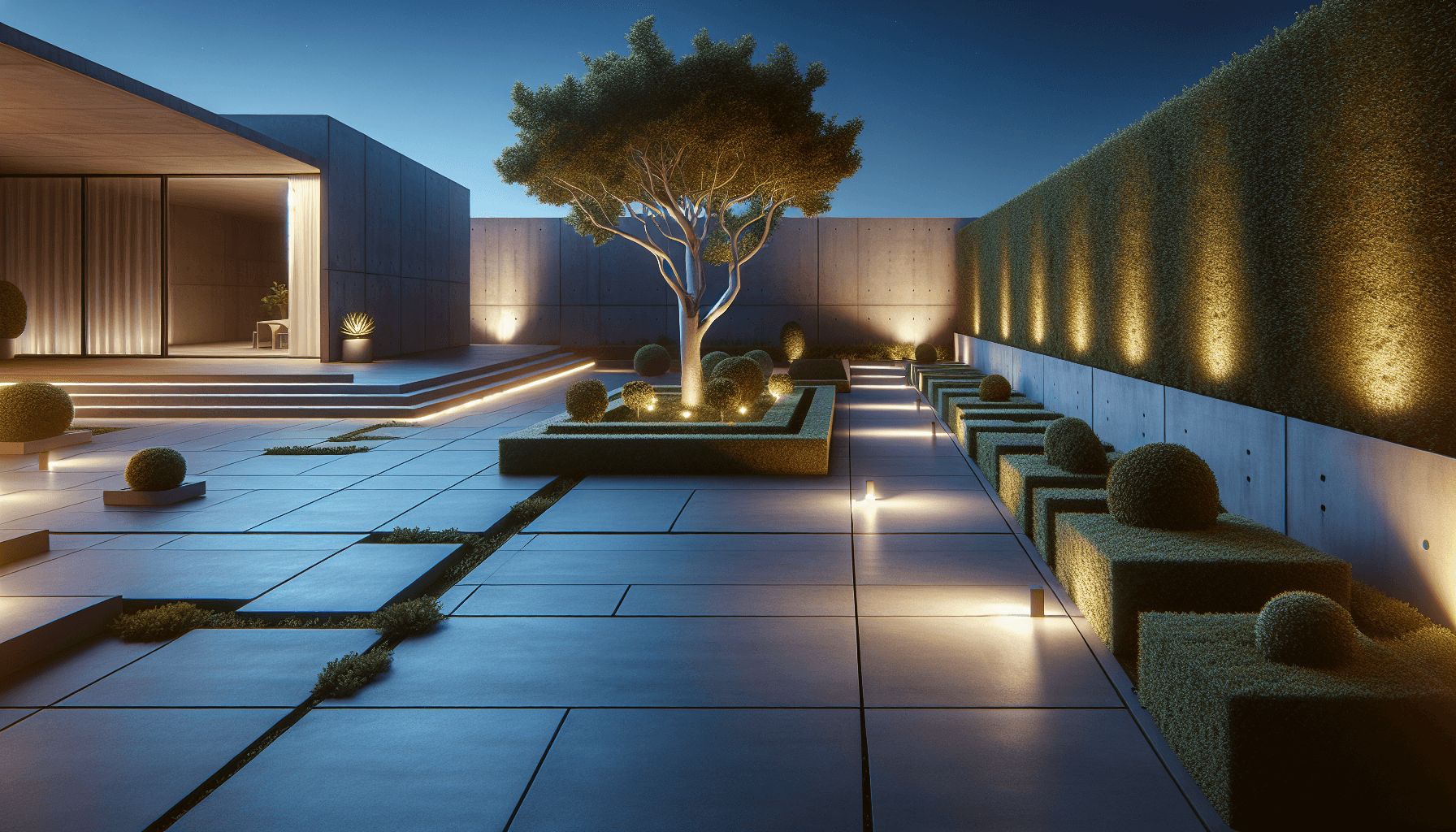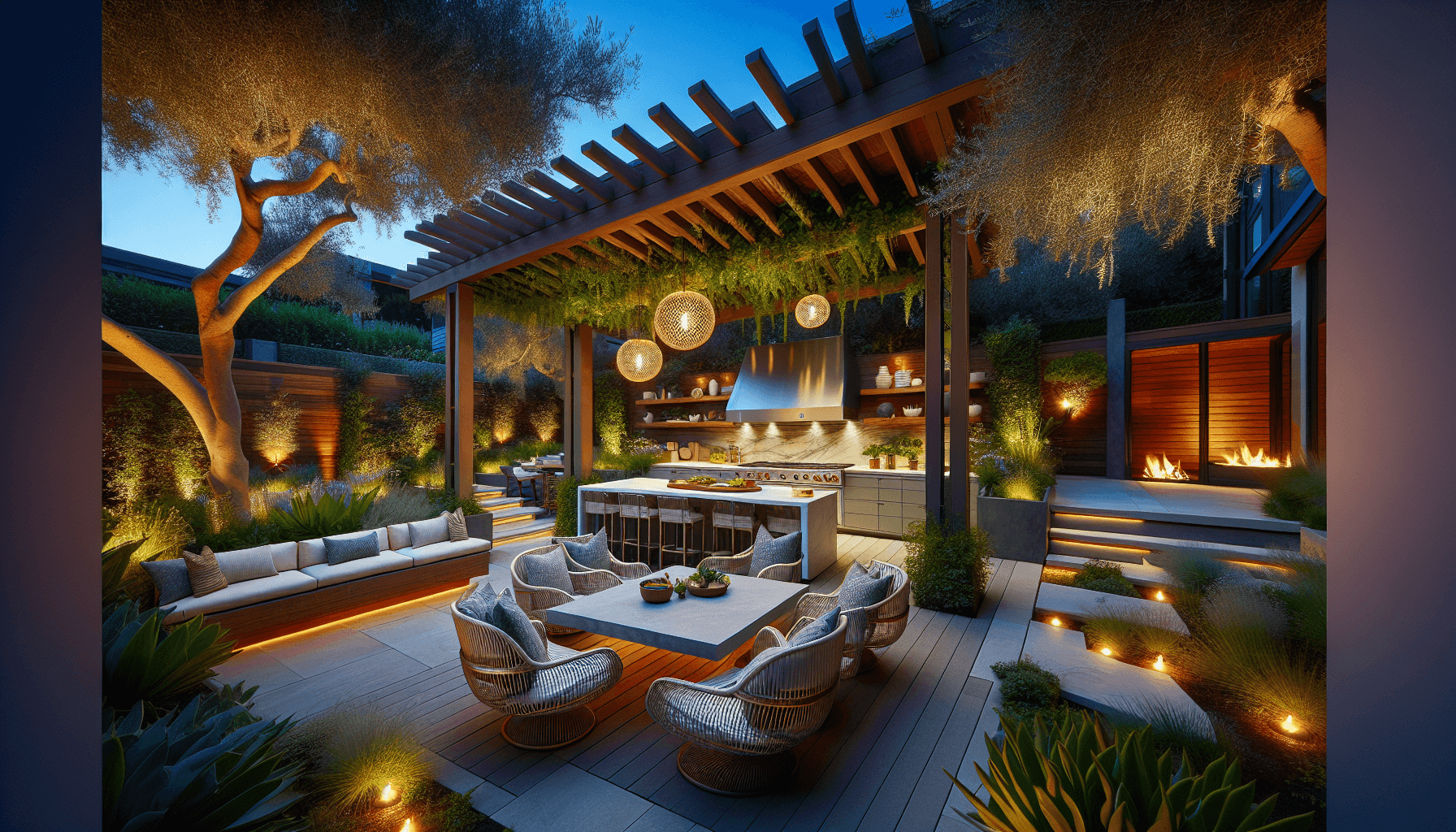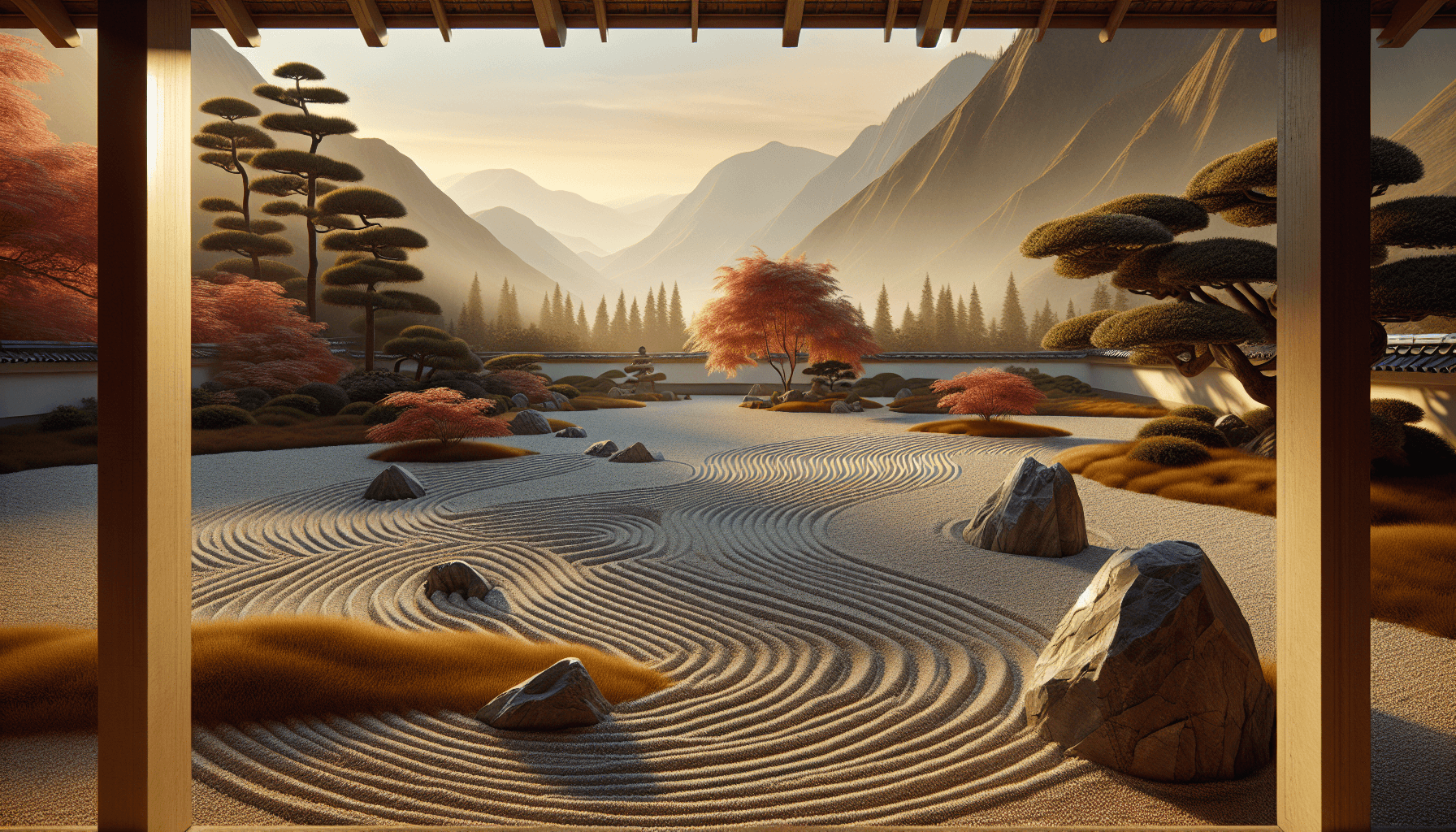Minimalism in landscape design isn't about emptiness—it's about clarity. It strips away clutter so the few elements that remain can shine: crisp paving, a sweep of turf, a single sculptural tree, and walls of green hedges that hold it all together. Add thoughtful lighting, and the garden becomes even more dramatic after dark.
A minimalist modern landscape offers visual serenity, requires strategic maintenance rather than constant upkeep, and creates a stunning backdrop for contemporary architecture. The result is a space that feels both calming and luxurious—perfect for entertaining or quiet evenings outdoors.
The Language of Minimalism Outdoors
Minimalist landscapes are defined by a refined vocabulary of design principles that create impact through restraint and precision:
- Strong geometry: Squares, rectangles, and long sightlines create structure and visual order
- Limited materials: Concrete, porcelain pavers, steel edging, and turf keep the palette simple and cohesive
- Green anchors: Hedges, clipped trees, or statement grasses bring life and softness to hard surfaces
- Space to breathe: Negative space—open turf panels or wide paving joints—is just as important as the plants
- Night drama: Lighting reveals texture and shadow, turning restraint into theater
When these elements work together, they create gardens that feel both spacious and intimate, simple yet sophisticated. The key is knowing what to remove as much as what to add.
Materials That Define the Look
Paving & Hardscape
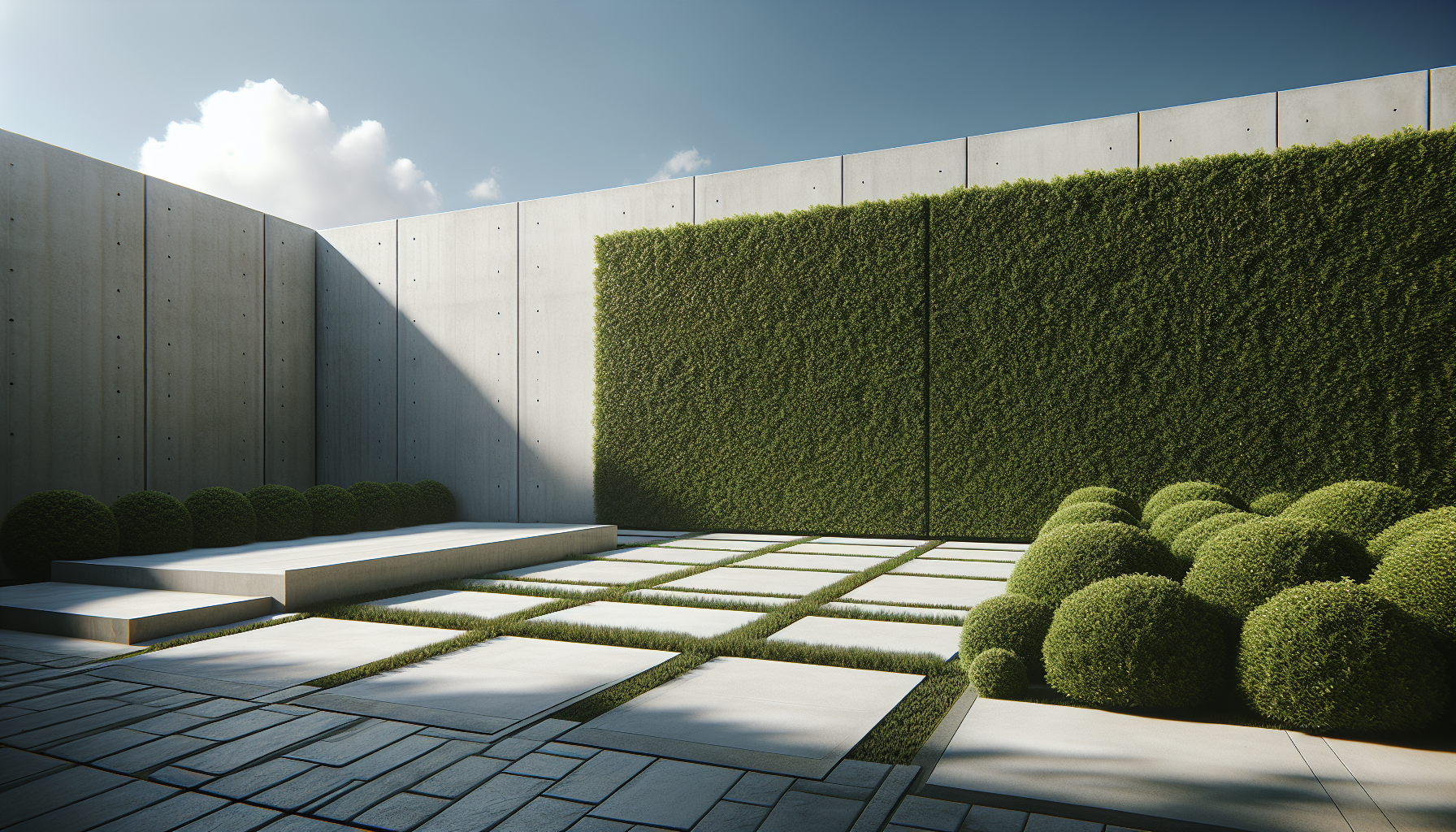
Smooth concrete with precision-clipped hedge creates clean geometry
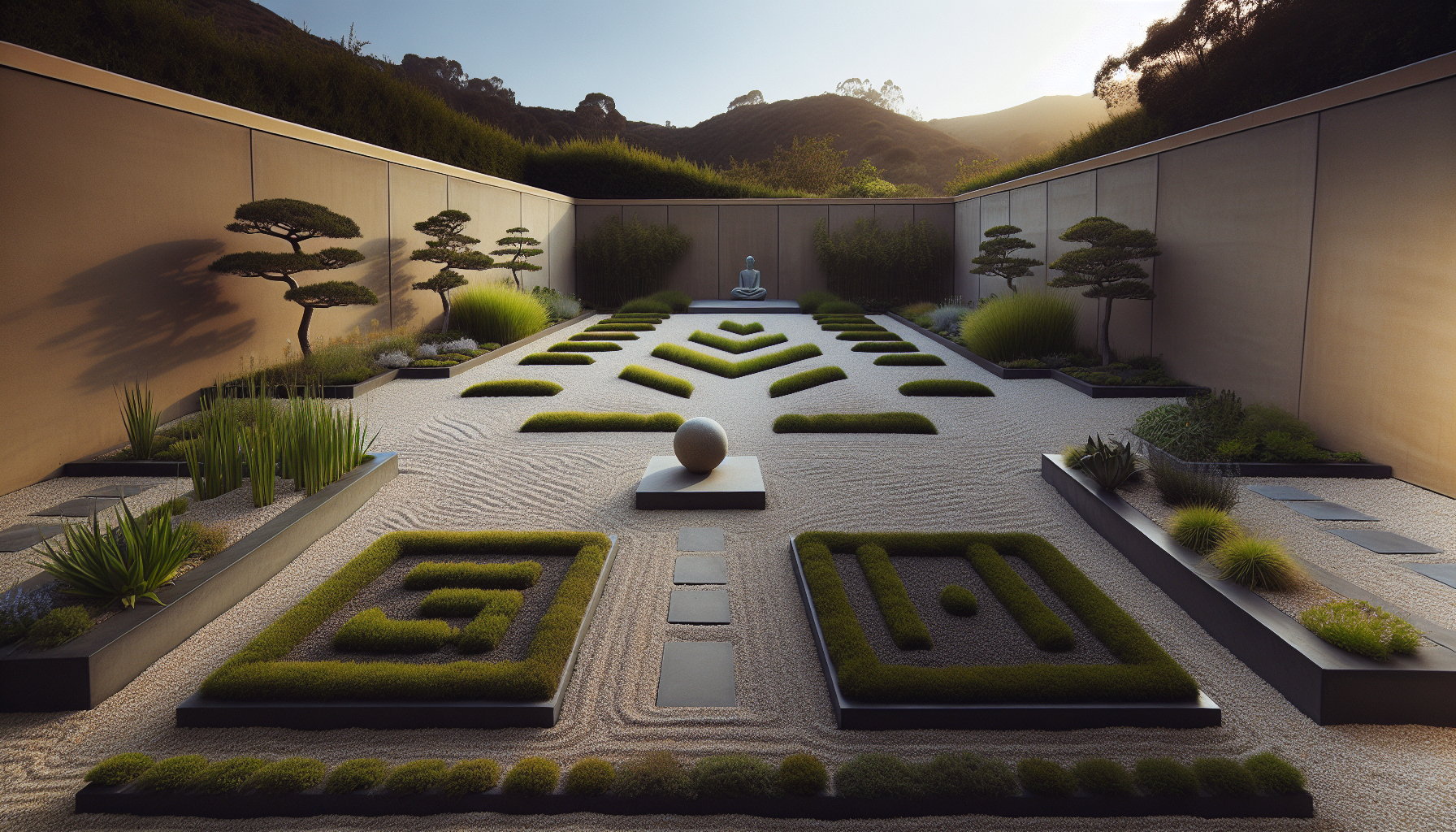
Gravel bands create subtle texture between paving panels
Recommended Materials
Concrete
Smooth, saw-cut panels or sandblasted finishes provide a contemporary edge. Large-format slabs create seamless transitions between indoor and outdoor spaces with minimal grout lines.
Porcelain Pavers
Large-format slabs (24"x48" or larger) in grey, charcoal, or limestone tones offer a luxury feel. Easy to clean, resistant to staining, and perfect near pools or high-traffic entertaining areas.
Decomposed Granite & Gravel
Used as accents or ribbons between panels rather than primary surfaces. Creates subtle texture and provides permeable zones for drainage.
Steel or Aluminum Edging
Essential for maintaining crisp lines between turf and gravel, or paving and planting beds. Creates invisible boundaries that keep the design sharp.
Turf as Living Canvas
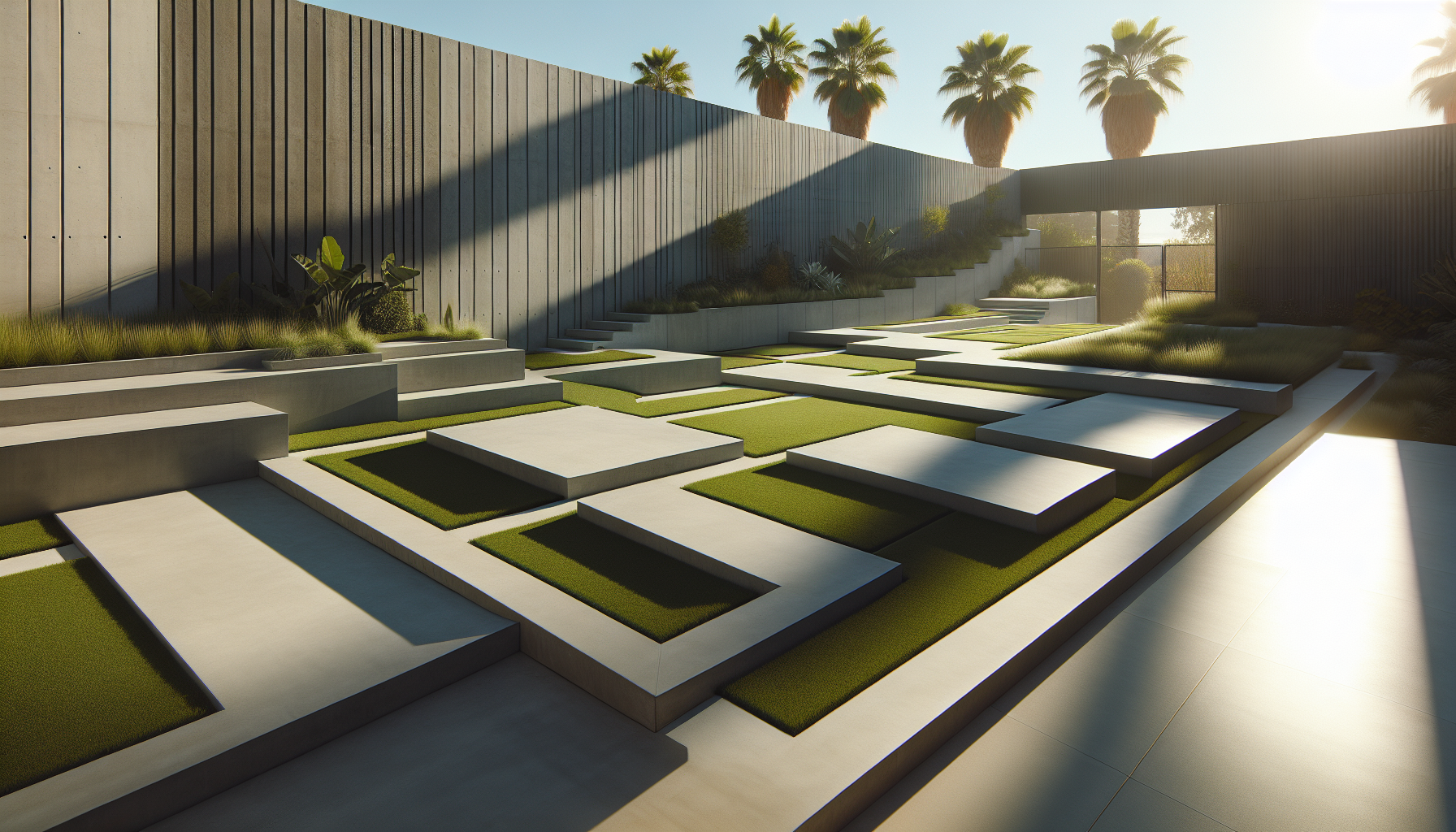
Turf panels create living geometry within hardscape frames
Natural Grass
Choose hardy low-water blends or hybrid bluegrass/fescue mixes for areas that will be used. Mow high (3") for a lush carpet effect. Deep-soak irrigation weekly in summer keeps it vibrant.
Artificial Turf
Best for showpiece panels or tight courtyards where maintenance is challenging. Choose premium products with varied blade heights. Pair with live hedges and trees so it doesn't look sterile.
Planting: Green That Frames, Not Fills
Minimalist gardens avoid fussy beds and excessive plant variety. Instead, they use strategic green anchors—plants that hold space, repeat rhythm, and stay evergreen year-round. Each plant must earn its place.
Hedges & Screens: Structured Walls of Green

Precision-maintained hedge creates living architecture
Essential Hedge Plants
Podocarpus gracilior (Fern Pine)
Clean vertical screen with dark green foliage. Clips beautifully into walls or columns. Excellent for creating garden rooms and property boundaries.
Prunus caroliniana 'Bright 'N Tight'
Dense, glossy hedge with narrow profile perfect for tight spaces. Fast-growing and naturally compact.
Buxus microphylla (Boxwood)
Low hedges for edges and parterre-style layouts. Classic choice for formal geometry and perimeter definition.
Anchor Trees: One or Two, Not Many
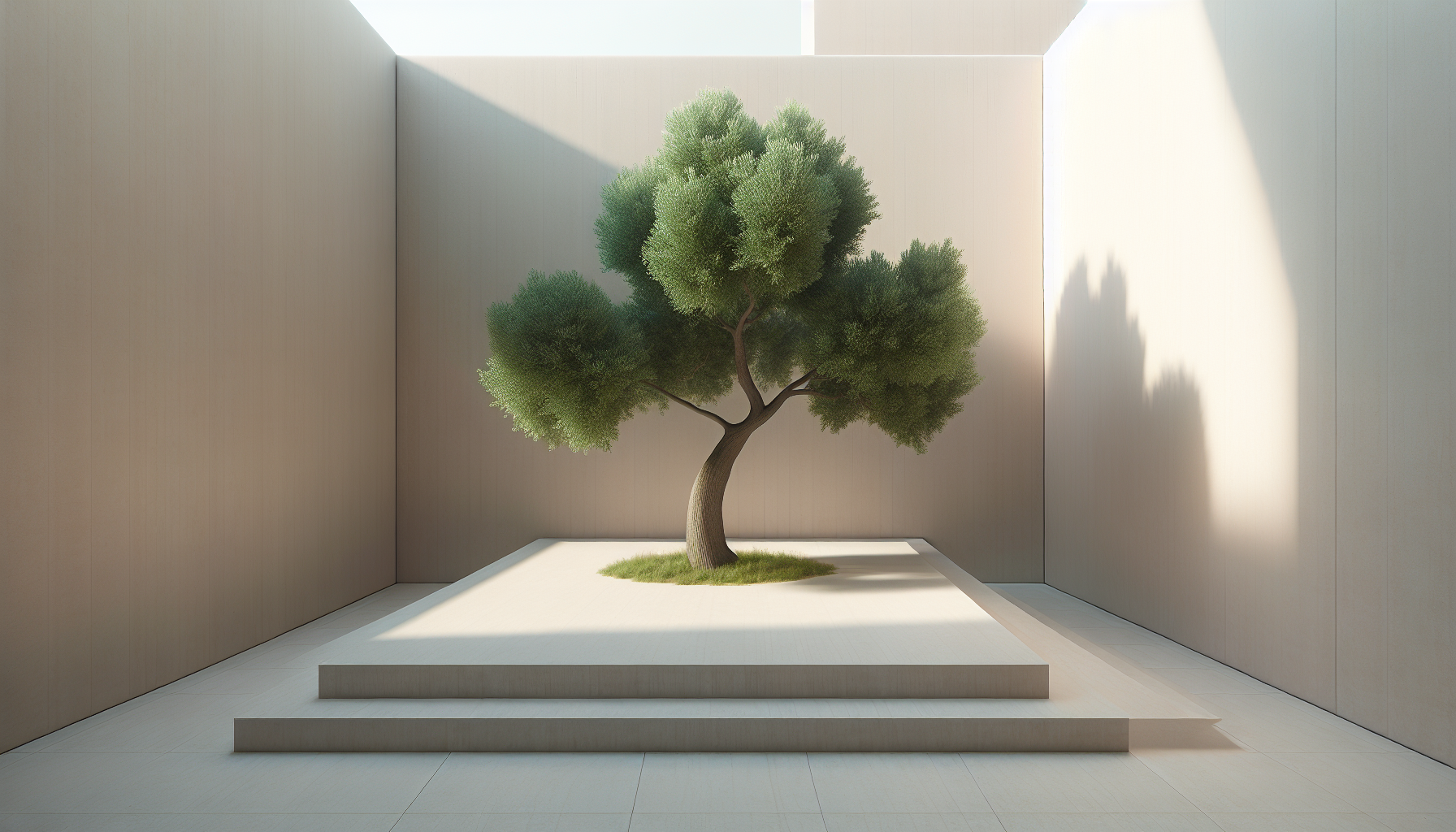
Single specimen tree becomes living sculpture
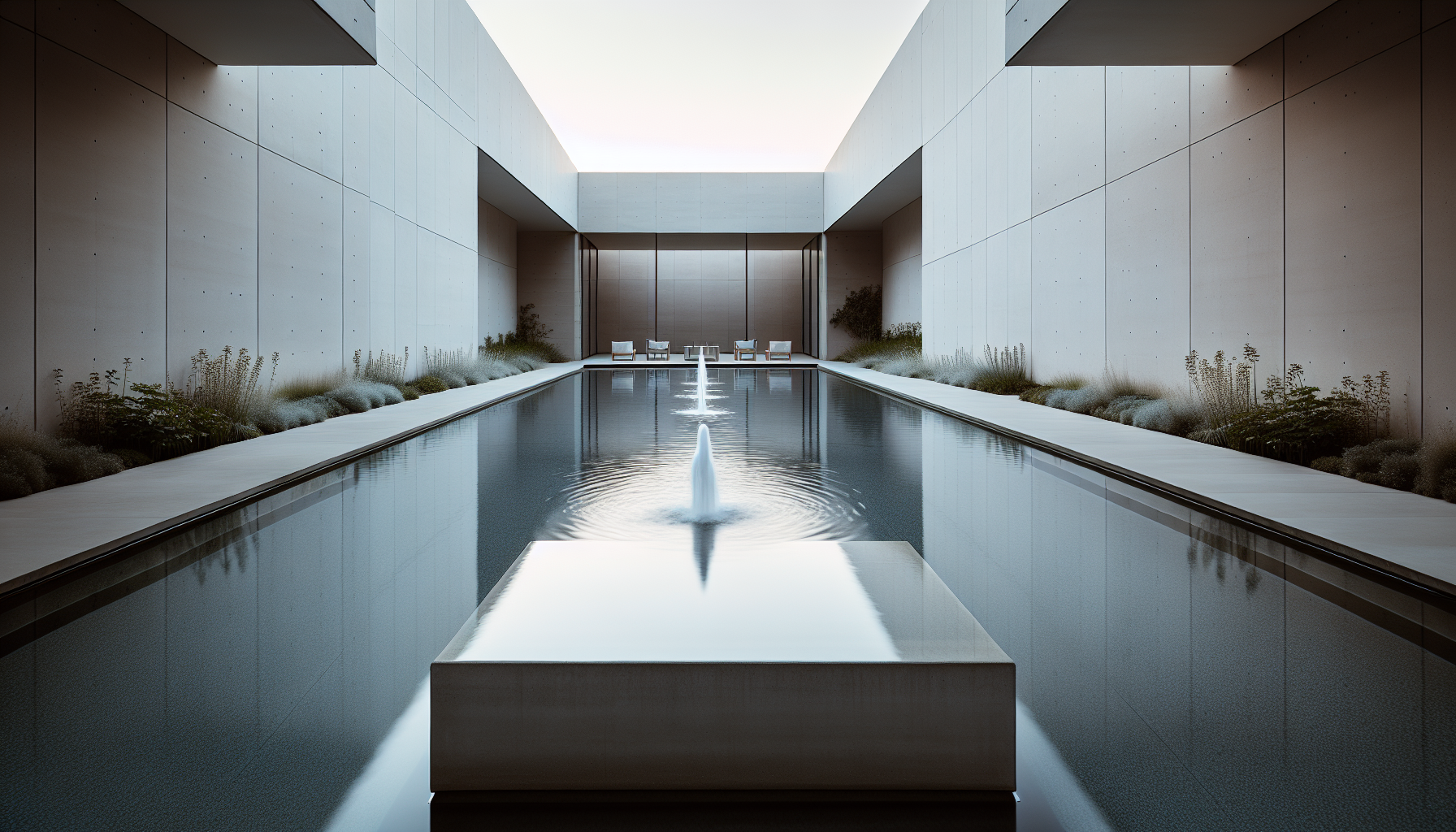
Reflection doubles the impact of carefully placed trees
Statement Trees
Olea europaea (Fruitless Olive)
Iconic, silvery, architectural canopy with gnarled character
Arbutus 'Marina'
Glossy evergreen with sculptural red bark and year-round interest
Acer palmatum (Japanese Maple)
In protected courtyards for dramatic seasonal color and delicate form
Citrus (Meyer Lemon, Kumquat)
In pots for fragrance, utility, and movable focal points
Grasses & Soft Accents
While minimalist gardens favor hard structure, strategic grasses and accent plants add movement, texture, and softness. Use them sparingly as punctuation marks rather than filling large areas.
Lomandra 'Breeze'
Green fountains that look perfect against concrete
Muhlenbergia rigens (Deer Grass)
Architectural clumps that light up beautifully at night
Phormium 'Black Adder'
Upright modern lines with dramatic color contrast
Night Lighting: Where Minimalism Comes Alive
Lighting transforms a minimalist landscape from restrained to dramatic. In daylight, the garden reads as simple geometry and green accents. At night, strategic lighting reveals texture, creates shadow play, and turns architectural elements into glowing features.
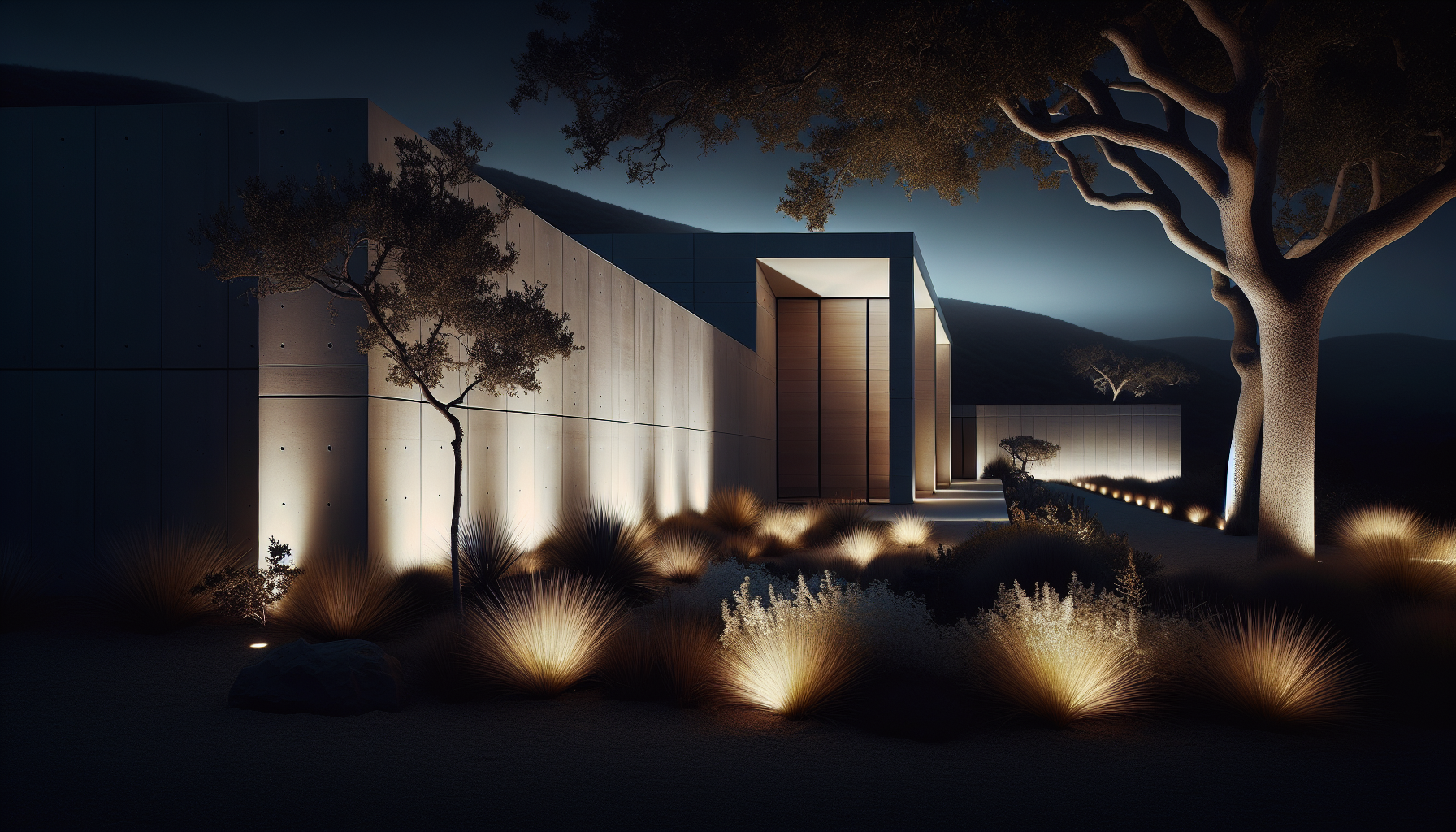
Strategic lighting transforms the garden into nighttime theater
Lighting Strategies
Uplight Hedges and Trees
Soft LED uplights at hedge bases turn a green wall into a glowing backdrop. Position fixtures 12-18" from hedge face for optimal effect. Highlight specimen trees from below to emphasize form and cast dramatic shadows on walls.
Edge Lighting
Slim linear LED strips under floating benches, concrete edges, or raised planters create a floating effect. This subtle glow defines boundaries without traditional fixtures cluttering sightlines.
Spotlight Accents
Highlight one olive tree or a trio of deer grasses with focused beams. In minimalist design, shadows become as important as the illuminated subjects—embrace the contrast.
Path Lighting
Use hidden or recessed fixtures rather than traditional lanterns. Light the surface, not the fixture. The goal is to guide movement while maintaining clean sightlines during the day.
Water Glow
When paired with pools or water features, use underwater LEDs in warm tones (2700-3000K) for resort-level atmosphere. Reflected light from water creates magical double-exposure effects.
Pro Tip: Color Temperature Matters
Stick to warm white LEDs (2700-3000K) for all outdoor lighting. Cool white or daylight bulbs feel harsh and commercial. Warm tones enhance wood, stone, and plant colors while creating inviting atmosphere. Replace all lamps with the same temperature for visual consistency.
Layout Ideas
The Courtyard Grid
Three or four large turf squares framed in porcelain pavers create a geometric composition. Plant one fruitless olive in the center panel, underlit at night. Border the space with boxwood or podocarpus hedge as the perimeter "wall." This layout works beautifully for side yards or enclosed entry courts.
The Linear Backyard
A long central panel of turf runs like a green runway through the space. Concrete or porcelain terrace flush with indoor flooring creates seamless transition. Plant podocarpus hedge along the property line, broken by one sculptural arbutus tree. Install linear LED strips flush in concrete edges for nighttime definition.
The Pool Terrace Minimalist
Oversized porcelain slabs extend to the water's edge without visual interruption. Plant a narrow ribbon of lomandra and phormium between pool and hedge. Place one olive tree in a square cutout planter, positioned for reflection in the water. Illuminate pool with warm white underwater LEDs and softly uplight the hedge backdrop.

Geometric turf panels create living rooms outdoors

Water features double as reflective surfaces
Care Tips That Keep It Minimal
Minimalist gardens require strategic maintenance rather than constant fussing. The key is preserving crisp lines and healthy plants through focused, periodic care.
Pruning
Hedges get a light shear 2-3 times per year to maintain crisp lines. Use sharp hedge trimmers for clean cuts. Thin olive or arbutus canopies lightly each year to preserve sculptural form and prevent overgrowth.
Turf Care
If natural, deep-soak irrigate weekly in summer and mow high (3") for a lush carpet effect. Edge meticulously to maintain geometric precision. Artificial turf needs occasional rinsing after heavy use and annual brushing to restore blade direction.
Grasses
Cut back deer grass and lomandra in late winter for fresh spring growth. Remove dead blades from phormium as needed. Mass plantings read better when all plants are cut at the same time for uniform appearance.
Lighting
Clean fixtures every 6 months to prevent dirt buildup that dims output. Replace lamps with the same warm temperature (2700K-3000K) for consistency. Check uplights haven't shifted position—hedge growth may require adjustment.
Hardscape
Sweep or blow paving regularly to prevent debris accumulation. Pressure wash porcelain annually to maintain pristine appearance. Check steel edging for rust and touch up with paint as needed.
Weeding
In minimalist designs, every weed is visible. Spot-treat as soon as they appear rather than waiting for major cleanup sessions. Consider pre-emergent herbicide in gravel areas twice yearly.
Why Minimalist Design Works

Every element becomes a focal point through restraint

Day to night transformation reveals hidden drama
Complements Contemporary Architecture
Minimalist landscapes extend the clean lines and material palette of modern homes. When indoor flooring flows seamlessly to outdoor paving, the living space effectively doubles. Large glass walls frame garden views as living art.
Creates Visual Serenity
In busy modern life, outdoor spaces become sanctuaries. Minimalist design removes visual noise so the mind can rest. The limited palette and simple geometry create a calming environment that never feels cluttered or overwhelming.
Makes Small Spaces Feel Larger
By reducing visual complexity and using continuous materials, minimalist design creates the illusion of more space. Long sightlines, monochromatic color schemes, and strategic focal points draw the eye through rather than stopping it with busy patterns.
Perfect Backdrop for Entertaining
Simple, clean landscapes become the perfect stage for gatherings. The design doesn't compete with people, food, or decor. Furniture arrangements remain flexible, and the space adapts to different uses—from intimate dinners to larger parties.
Getting Started
Your Minimalist Garden Journey
-
1.
Define Your Spaces
Map out functional zones: entertaining terrace, quiet sitting area, circulation paths. Minimalist design requires clarity about how spaces will be used.
-
2.
Choose Your Material Palette
Select 2-3 primary materials maximum. Consistency is crucial—one paving type, one hedge variety, one accent grass. More materials = less minimal.
-
3.
Install Hardscape First
Paving, edging, and built features set the framework. Get these levels and alignments perfect—mistakes in minimalist design have nowhere to hide.
-
4.
Add Green Structure
Plant hedges and anchor trees next. These define space and provide evergreen bones. Use larger specimens if budget allows—they establish the design immediately.
-
5.
Layer Lighting Last
Once plants are in place, add lighting to highlight key features. Test positions before final installation—lighting effects change dramatically with small adjustments.
-
6.
Embrace the Process
Hedges need 1-2 years to fill in completely. Trees gain character with age. The design matures beautifully if you maintain crisp edges and clean lines from day one.
Minimalist design is not sterile when it's done right. The paving gives structure, the turf gives life, the hedges give enclosure, and the lighting gives drama. Together, they make a garden that feels both calming and luxurious—a space that enhances rather than competes with your home's architecture.
Start with restraint: choose fewer materials, fewer plant varieties, and stronger geometry. The result will be a landscape that ages gracefully, requires strategic rather than constant maintenance, and provides a serene backdrop for modern living. Your minimalist garden becomes a canvas for light, shadow, and the changing seasons—nothing more, nothing less.
